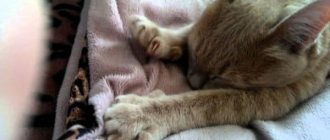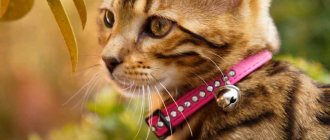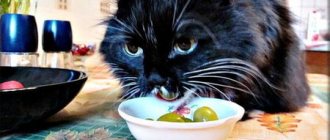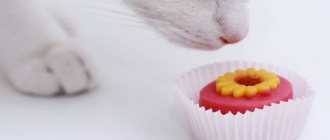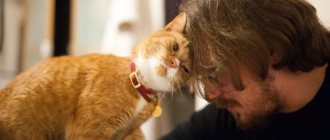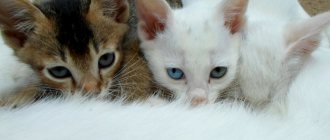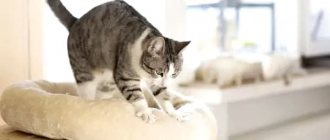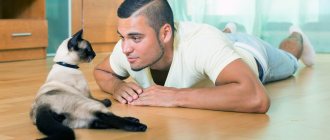Cats are amazing creatures, such familiar animals that have lived next to us for several millennia, conceal quite a few secrets, and there are also a huge number of myths and legends around them. Their behavior is sometimes completely incomprehensible and raises many questions. For example, the usual trampling of our paws, what causes it? Why do cats start doing this massage?
You? finally? Fulfilled a dream and got a pet. They decided how and what to feed him and trained him to use the tray. The cat is already spending time with you with great pleasure: playing, sleeping next to you, talking in his cat language. Some, of course, are very freedom-loving and do not like tight hugs, but you have noticed that from time to time your pet moves its paws. What does it mean when a cat gives a massage?
A cat paw massage is an expression of love.
Most often, experienced owners note that the cat gives a massage in a state of “nirvana”, when the pet is completely relaxed and peaceful. Most often, a soft surface is chosen for the milk step - a blanket, toy, pillow or the lap of a beloved owner. Some cats make these movements harmlessly - without extending their claws, but there are those who extend them to their full length.
So, why do cats massage? There are actually many reasons; this movement can be caused by both physiological and psychological factors, as well as instinctive ones. To understand your pet even better, you should familiarize yourself with them.
How to stop a cat without offending it
When an animal willingly tramples on its owner and purrs, it gives the person painful sensations due to the extended claws.
Cats can exert such force that they begin to pierce human skin, especially painful sensations in the abdomen and thighs. It is not recommended to scold an animal, since it shows care and affection, but there is no point in tolerating it. Note! If you yell at a pet, it will leave, but still will not understand what caused such a reaction from the owner. In order not to offend your pet and stop the process, you must do one of the following:
In order not to offend your pet and stop the process, you must do one of the following:
- abstraction. The owner simply needs to change the nature of the caresses. Due to a change in sensations, the beloved animal will stop releasing its claws for a certain period of time;
- putting the pet down. If your pet is trampling too actively, causing discomfort and pain, it is recommended to start stroking it more actively and gradually lay it on its side. This approach helps to quickly stop trampling with claws out without offending the pet;
- gentle stroking of the paws when the cat is trampling, forces it to hide its sharp claws and continue the massage without their participation. If you do this every time your pet gets carried away with the massage. After a short period of time, the cat will develop an addiction and will stop releasing its claws altogether.
Important! All veterinarians, psychologists and simply scientists unanimously repeat that it is impossible to scold a pet for trampling, since this manifestation is exclusively positive. A negative reaction can cause psychological trauma to the pet, and he will worry about not understanding why he was punished, etc.
d.
How to stroke a cat's paws so it doesn't scratch
What a person is prohibited from doing
If an animal crumples its paws and does not release its claws, then such a massage may even seem pleasant to a person. But what if the cat gets carried away and begins to cause pain to its owner?
Basic recommendations that will allow you to unobtrusively show your pet that it is better to hide the claws:
- cats are easily distracted by toys and affection;
- If the pet is very carried away, it is recommended to simply stroke its front paws on top. Due to the change in sensations, the animal will not run away out of fear, but will hide its claws.
As has been said many times before, it is forbidden to shout, raise your voice, or even beat an animal. It is not recommended to sharply push the cat away, pull its paws or rudely drive it away. This can not only undermine trust, but also cause extreme stress.
For your information! Having been offended by their owner, cats can take revenge. Most often they shit in the wrong places.
How cats show their love
By nature, cats are peace-loving creatures, and finding a common language with them will not be difficult. Trampling with paws on soft surfaces or on a person’s body is a manifestation of love and good mood.
Indications for massage procedures
The kitten feels the beneficial effects of massage movements from birth; postpartum licking by a cat tones the baby, stimulates processes in the body, and encourages action. Regular massaging of the abdomen is necessary for the baby's digestion. Massage of the tummy and body is mandatory for kittens left without a mother.
Old animals also need additional stress and exercise. Kneading exercises improve the quality and duration of their life, relieve pain, and stimulate the functioning of the kidneys and intestines.
Very active and sedentary animals benefit from massage to normalize muscle tone.
Massage is especially indicated for conditions such as:
- paralysis and paresis after falls and accidents;
- injuries (rehabilitation);
- some congenital and genetic diseases;
- restriction of movements for a long time for various reasons;
- joint dysplasia in large breeds of cats.
A little about cat physiology and the reasons for this behavior
Cat massage attracts a lot of interest among pet owners. From a physiological point of view, there is a rational explanation why a pet tramples its beloved owner with its paws.
So, as mentioned earlier, stomping is a way of marking territory. The paws contain a large number of ducts and sweat glands that produce and secrete a special secretion. In addition, the paws of all types of cats are sensitive due to the large number of receptors and nerve endings. It is inherent in nature that animals receive a large flow of information about the world around them in this way.
The results of numerous scientific studies have also shown that during diligent pawing and trampling, the pets’ body begins to actively produce endorphin - the hormone of happiness, which allows you to relieve stress, calm down and, of course, relax.
Ancient Egyptian painting featuring cats
For pleasure
Cats trample because they enjoy it. The usual pawing and releasing of claws gives them true pleasure. In the process of action, they purr loudly. You can even “read” from its face that at this moment the animal is in complete harmony with itself and the world around it. And if the object of trampling is a loving owner, then the Murka’s joy will be double.
It happens that a furry girl hurts a person during a massage with sharp claws. There is no need to push the animal away or darken her feelings with rudeness. It’s better to gently stroke her paws so that the kitty hides her prickly fingers and continues to “get high.”
A little about cat physiology and the reasons for this behavior
These creatures differ from other animals in that they have a highly developed sense of touch. Whiskers, eyebrows, paws are areas that expand the perception of the world. There are many receptors and glands on the pads, the whiskers play the role of an indicator of the emotional state, and vary in shape, depending on the breed.
Cats tend to stomp around in one place, moving their paws as if kneading dough, sometimes releasing their claws, accompanied by purring. This movement is called the “milk step”. These tender expressions of affection apply to humans or other animals as well as to inanimate objects.
Psychological release
Pets experience stress associated with lack of attention, a trip to the veterinarian, a new neighbor and other reasons. Offended or upset cats relieve tension through a release ritual - they trample furniture, extending their claws, or knead a soft blanket or pillow with their paws. During such therapy, the animal releases endorphins, which helps it calm down. If you interfere, it may bite your hand.
Childhood memories
This instinctive movement of the paws in kittens is one of the first, appearing at birth. Babies, nudging into the cat’s belly and massaging it, stimulate milk production. Animals associate feeding time only with positive emotions. They remember how warm and cozy it was next to their mother. Having reached adulthood, feeling full and safe, pets involuntarily reproduce movements from childhood, shifting a blanket or sofa.
Preparation for sleep
Another cat instinct is related to preparing a place to sleep. In their natural environment, animals trample, crushing grass and leaves to prepare a bed. According to some animal psychologists, this instinct has survived to this day, but only in a number of pets. Therefore, the pet tramples the already soft pillow with its front paws before going to bed.
Mating season
The time of mating also forces the darlings to perform this simple action. Estrus is a period of sexual arousal that is extremely difficult to confuse with something else, since the cat begins to actively knead the blanket, arch its back, and move its hind legs, accompanying this with an expressive meow.
After 10-14 days or with the onset of pregnancy, this will pass.
Taking care of the owner
Mustachioed pets show care for a person both through purring and a kind of massage.
Cats feel the approach of a disease, therefore, by sitting on the same part of the body, they try to treat the owner, taking away negative energy. If the cat constantly lies only on his lap, it is better to check if everything is in order with the health of the joints.
Love and devotion
Animal psychologists argue that a high level of trust in a person is another reason for such behavior. So if a pet crushes its owner with its paw pads, it is showing love.
Cats can trample on the body, expressing gratitude for stroking. When the pet, purring, runs through the hair with its paws, it marks the person as its property, trying to protect it from competitors.
Other reasons
The reasons listed are the most common, but it is worth considering less frequent motives for such behavior.
Hunting instinct
Experienced breeders attribute some of the behavior of their pets to ancient instincts. Pets crumple soft things and scratch furniture not in an attempt to annoy them, but in obedience to hunting reflexes.
The wild ancestors of modern cats checked the surface under their paws so that nothing would interfere at the moment of attack, neither too soft soil nor rustling. Cats have not yet forgotten their natural skills, but they do not always use them for their intended purpose.
Territory
According to one theory, this action is a desire to mark territory. There are many glands located on the paw pads. The secret they secrete remains on the surface of the object that the pet crushed. This behavior is more characteristic of cats than cats, and means that the animal is marking its territory.
Probable Causes
Experts in the field of animal psychology identify several reasons why cats knead their paws. This ritual has the following explanations and theories:
- Memory of childhood. A newborn baby, feeding on mother's milk, kneads the mother's mammary glands with its paws. This massage stimulates milk production, which is important when the cat has more than one baby. At the same time, feeding itself causes positive emotions in the pet. Having matured, many kittens perceive their caring owners as their cat mother. Having transferred their pleasant childhood memories to humans, young animals settle down next to their beloved owner and begin to touch their paws.
It is for this reason that cat breeders call this ritual the “milk step.” Owners often notice that the kitten not only wiggles its paws, but also purrs contentedly and even drools with pleasure. This theory is supported by the fact that artificially fed pets are not capable of the “milk step”.
- One of the reasons why cats paw is their natural instincts. Being once wild predators, animals carefully prepared places for rest and overnight: they trampled down hard grass, making the nest cozy and soft. In the wild, representatives of the cat family use grass and leaves to make a nest. To make your sleeping area comfortable and safe, it needs to be put in order. The most convenient way to do this is to crush objects with your paws.
The desire to equip one’s territory, a place to rest and sleep, is also characteristic of modern domestic couch potatoes. And although most pets live in comfortable conditions, nevertheless, they have not lost the ancient instinct of their wild ancestors. In addition, the cat often crushes soft objects with its paws, arranging a nest for birth and future offspring. Often this behavior is a sign of impending labor.
- Hunting instinct. Some experts believe that domestic cats knead a soft surface, obeying the ancient hunting instinct. Predators by nature, pets have not lost the ancient skills of this skill. Their wild counterparts, before jumping on the prey, crush the surface with their paws, testing it for stability and hardness. It is important for a predator that at a crucial moment a branch does not snap under its paw. Fluffy couch potatoes have not lost their natural instincts, but they do not always use them for their intended purpose.
- Territorial version. Some zoologists are inclined to believe that the reason why cats crush their owners' paws is their desire to mark their territory. There are specific glands on the pads of cats' paws, with the help of which they identify their possessions and territory.
Considering its beloved owner to be its property, the animal leaves its scent on his body, making it clear to other individuals that they can no longer have the right to the owner’s attention. Thus, the ritual serves as a kind of marker to mark one’s property and possessions.
- Psychological release. The psycho-emotional tension or stress accumulated by the pet requires release. Some animal psychologists, not without reason, believe that the reason why cats knead the blanket with their paws is self-soothing. At the same time, the animal practically disconnects from the outside world and focuses on its internal sensations. Monotonous paw movements and purring help calm the pet.
This point of view is supported by the fact that during the “milk step” the cat’s body produces endorphins - specific substances, hormones of happiness. They reduce anxiety and fear in pets.
- Other factors. Experienced breeders believe that the reason for the cat ritual is a high degree of trust and love for its owner. Many cat fans believe that animals perform such a ritual for a healing purpose - they treat their owner from various ailments, taking away negative energy.
Another reason why cats massage their paws is sexual behavior. As a rule, in the spring, with increasing daylight hours, the production of sex hormones increases, which in some individuals is accompanied by a “milk step”. The variety of theories, versions and guesses regarding a peculiar ritual inherent only to representatives of the feline family once again testifies to the mystery and enigma of domestic cats.
None And here is more information about how to remove a cat from a tree yourself and with the help of special services.
[custom_ads_shortcode2]
A cat mashes a person with its paws when he is sick
Among animal owners, there is also a mystical explanation for why a cat crushes a person with its paws. It is associated with the ability of purrs to warn us about the presence of various ailments. Of course, this is not confirmed by any research, only by the personal experience of the narrators, so diseases need to be diagnosed by doctors.
The only exception may be diseases associated with increased body temperature. A “hotter” person serves as a comfortable source of heat for the cat, but again, the animal, of course, cannot “make a diagnosis” and distinguish a cold from, for example, cancer or a serious inflammatory process.
Why do cats trample their paws and purr?
Why a cat tramples its paws: the main reasons and what it means
A cat massages its paws - what does this mean? There is no exact interpretation, but scientists and simply cat lovers put forward several interesting versions. Each one undoubtedly deserves attention.
There is another widespread theory - an animal tramples its owner when it wants to improve his physical and psycho-emotional state. Sometimes people’s pain actually goes away due to the rush of blood to the place where the caring pet is trampling. There are several solutions to the problem - be patient and wait it out, find a friend for your pet, or have it spayed/neutered.
Note! Releasing claws and trampling are always, without exception, a manifestation of positive emotions, so you should not shout at your pet if she is scratched, you need to show your concern in return
What to do if you don't like cat trampling
You can improve your relationship with your beloved pet if you praise and pet the cat while stomping. At the same time, a person may experience unpleasant sensations, because often fluffies, in impulses of feelings, release their claws and scratch the owner’s back and knees. If you can’t influence it in any way, then it’s time to accustom your pet to a scratching post.
To do this you should:
- find a place special for this procedure;
- interest the pet;
- cover things and furniture from the kitten;
- respond correctly to your pet’s behavior;
- encourage him;
- do not resort to extreme methods.
If, for example, a cat likes to sharpen its claws on a chair, then this item should be chosen as a scratching post and placed in a place where there are no sharp sounds. For example, in the kitchen or bathroom, where there is often noise from the washing machine, dishwasher and other items, you should not place a chair.
It is better to smear the leg of a chair or other scratching post with catnip. If your pet ignores it, it means it doesn’t suit him or he doesn’t like the material from which the bait is made. You can try another object as a scratching post. To do this, purchase wooden, cardboard, jute or other cat objects of desire in a special store.
Accustoming your pet to a scratching post is a complex process.
To protect furniture from fluffies, it is recommended to put special covers on it. Clothes and shoes do not need to be kept on open shelves. Cats do not like the smell of orange, so it is recommended to lubricate all objects in the house with orange juice. The owner's back and knees can also be lubricated with this juice.
Note! If the pet does sharpen its claws in the right place, you need to praise it and encourage its behavior. You can and should treat the cat with a treat, stroke its head and fur. This action of the owner will reinforce a useful habit in the pets.
At the moment when a four-legged animal has done the wrong thing, scratched the furniture or the owner himself, you should not frighten or scold him, much less beat him. Most likely, she will not understand the owner’s behavior and will take revenge. It is recommended to make a little noise at the animal and take it to the scene of the “crime”.
Some owners, wishing for a quiet life, turn to the veterinarian with a request to surgically remove the cat's claws. This is absolutely forbidden to do this, because this procedure has a negative psychological effect on the fluffies. Pet stores sell special covers for kittens, but their use is also prohibited, because they prevent cats from tearing their claws. And it’s nature’s way for pets to do this, because over the course of their lives they begin to flake off. In addition, under the covers, the four-legged paws begin to itch very much, which causes severe discomfort.
It is easier to accustom a kitten to a scratching post than a mature cat. However, it is never too late to start learning. Love works wonders. A kind and attentive attitude will help you acquire a loyal and caring friend in the face of cats.
Veterinarians also advise trimming claws, both back and front. You cannot do this on your own, as you can harm your pet. The effect will be created if you take a fluffy’s paw and press on the pad, and with the released claws walk over the cat itself. After doing this several times, the cat herself will understand how unpleasant it is and will stop releasing her claws during massaging.
Summarizing, we can come to the conclusion that cats that trample their owners with their paws have a number of advantages. The main reason why a cat sits on the back or lap of the owners is feline therapy, or the ability of cats to heal sore spots in humans. Scientists have found that they feel an approaching heart attack or find a tumor in their beloved owners, who replace their mother cat. If your ward is trampling his paws on his stomach, maybe you should see a doctor instead of kicking the kitten?
These affectionate fluffies love children and are attentive to pregnant women. From birth they are ruled by instincts. They get used to working, because in order to get milk from their mother, they press their paws on the mother’s belly. Therefore, having matured and not having forgotten this ritual, pets experience true pleasure from trampling their owners’ knees and backs with their paws. The owner can only lie down comfortably, cover the pet with a blanket so that he feels comfortable and begins to perform a “massage” with his soft paws. Instead of fighting, it's better to enjoy the process.
Agree, there is something bewitching and even mystical in a cat that tramples on a person and purrs. At the same time, she usually looks absent, her eyes are half-closed. It seems that she is performing some kind of ancient ritual, the meaning of which is known only to representatives of this mysterious mustachioed family. But people, even though they are simpletons compared to cats, still managed to get closer to solving this mystery. Scientists have put forward several versions of why a cat tramples its paws.
Therapeutic effect
When cats touch and crush a person with their paws, they share their energy and take away all the negativity. In addition, cat massage has other medicinal properties, due to which animals are used in medicine. Here are just a few facts:
It is worth noting the phenomenal intuition of furry pets, who subtly sense the approach of death and human illness. That is why they often come and lie on a sore spot on the body or near the bed of the dying person.
All these unique skills of pets must be appreciated by showing your attention and care for cats. Only then will they reciprocate and relieve headaches and stress
A little about cat physiology and the reasons for this behavior
Why does a cat lick a person: the main reasons and what it means
Cat massage attracts a lot of interest among pet owners. From a physiological point of view, there is a rational explanation why a pet tramples its beloved owner with its paws.
So, as mentioned earlier, stomping is a way of marking territory. The paws contain a large number of ducts and sweat glands that produce and secrete a special secretion. In addition, the paws of all types of cats are sensitive due to the large number of receptors and nerve endings. It is inherent in nature that animals receive a large flow of information about the world around them in this way.
The results of numerous scientific studies have also shown that during diligent pawing and trampling, the pets’ body begins to actively produce endorphin - the hormone of happiness, which allows you to relieve stress, calm down and, of course, relax.
Ancient Egyptian painting featuring cats
A Brief History of Cat Domestication
By nature, cats are predators. These animals are freedom-loving and have a rather capricious character. A large number of scientists have been and are still studying the issue of domestication. It is assumed that the ancestor of today's domestic cats was the dun cat, which lived in the wild in North Africa. In appearance, it is most similar to modern pets. The Egyptians first started keeping it at home.
The structure of cats' paws
Initially, these animals actively spread throughout the territory of Ancient Egypt. This began during periods of agricultural development. After all, granaries of impressive size inevitably attracted the attention of rodents, which cats love to feast on.
For your information! In Egypt, cats were revered as sacred animals. The sun god has the form of a cat. Exporting animals outside the country was strictly prohibited; it was punishable by death.
These animals first appeared in Rus' in the 14th century. They were also loved and revered. The theft of a pet was subject to a fine commensurate with the fine for the theft of cattle.
The brown cat is the first domesticated pet
Surprisingly, in the Middle Ages in Europe, cats were considered involved in witchcraft, especially black animals. The final persecution ceased only in the mid-19th century.
Indications for the procedure
Cats normally defecate once a day. Animals over 7 years old go to the toilet approximately once every 2 days. If there is no bowel movement for more than 3 days, the cat is constipated.
Typical symptoms:
- restless behavior;
- lethargy;
- refusal of food;
- bloating.
When constipated, the pet sits in the litter box and strains, but does not defecate. Sometimes dry and hard feces are passed in small quantities. However, this does not solve the problem.
You can help your pet yourself. Massage during constipation improves the functioning of the gastrointestinal tract, increases the elasticity of the walls and enhances intestinal motility, which stimulates the release of feces.
Important. If measures are not taken, the body will no longer cope with decay products, the load on the heart will increase, and the functioning of the liver and kidneys will worsen. All this leads to serious complications, including death.
All this leads to serious complications, including death.
Massage is performed for the following problems:
- Constipation due to stress. If the cause is eliminated in a timely manner, massage will normalize bowel movements without the use of medications.
- Chronic constipation. Stool disorders will appear much less frequently. It will be possible to reduce the dosage of medications or stop taking them altogether.
- Constipation in a cat due to a sedentary lifestyle. Typically seen in older animals who become less active.
- Constipation due to changes in diet or poor diet. Difficulty defecating is caused by insufficient fiber intake or a sudden change in food.
- Constipation in obesity. In overweight cats, metabolic processes slow down, which leads to the appearance of dry feces and untimely bowel movements.
It is useful to do massage after birth if the cat has no complications and is in satisfactory condition. The procedure speeds up the recovery of the body and prevents the occurrence of mastitis and other diseases.
If, in addition to constipation, your cat has a fever (above 39.5°C) and vomiting, you should immediately contact your veterinarian. Most likely, she has some serious illness.
Massage is a safe and effective procedure that acts in several directions at once:
- strengthens and tones the abdominal muscles;
- stimulates the movement of feces;
- activates lymph flow and blood circulation;
- relieves pain;
- eliminates spasms;
- reduces gas formation.
Massage is useful even if there is no constipation. It helps to establish a trusting relationship with your pet. Tactile contact brings people closer together and relaxes them. And if you follow the technique, the procedure will be pleasant for the cat.
Massage is used to treat constipation when the cat’s general condition does not cause concern. The procedure is not carried out:
- for dermatological diseases and skin damage on the abdomen;
- inflammatory diseases of the musculoskeletal system;
- colitis, gastritis and other gastrointestinal diseases;
- spasms of the large intestine;
- suspected benign or malignant tumor;
- intestinal hernia or tumor;
- volvulus;
- exhaustion of the cat’s body;
- blockage of the intestine by a foreign body;
- during pregnancy.
After abdominal operations (caesarean section, sterilization), massage is not performed for 6 months.
Constipation sometimes occurs in cats that have broken their pelvic bones. Improper fusion of bones or adhesions leads to defecation problems. To understand the cause, an x-ray is first taken.
Belly massage is also recommended for kittens and older cats. However, it is better to consult a veterinarian first. Excessive or awkward movements can injure your pet.
Massage technique
The procedure must be carried out at least two hours after eating, and it is necessary to choose a time when the cat is calm and not busy with important things (sleeping, playing, licking itself, etc.). It is better to start with light scratching or stroking, and then move on to more intense manipulations. If the animal is worried or tries to run away, there is no need to restrain it by force - it is better to interrupt the massage and repeat it after 30-40 minutes.
Relaxation massage technique
There is no universal massage technique - during the procedure you need to monitor the cat’s reaction and adjust your actions depending on its behavior.
- All movements are performed with the palm of one or both hands - a massage done with the fingertips will be too weak and may cause discomfort.
- The massage should be performed in the direction from the middle of the body to the limbs.
- It's best to start with the neck, lightly moving your fingers through it and not applying too much force.
- Next, you should move to the upper part of the body - work the shoulders and front legs in a circular motion, and then massage the back to the hips in the same way.
- Massage of the thighs should be very careful, using stroking movements, as they are one of the most sensitive places in cats.
- The tail can only be massaged if the cat does not twitch it, moving from the tip to the hips.
- Lastly, they work on the head - first the crown, then the areas around the ears and temples.
- At the end of the procedure, you should confidently, but without strong pressure, run your palm several times over the entire body of the pet.
The average length of a relaxation massage is 10-15 minutes, with approximately the same amount of time spent on each area.
In the absence of contraindications, massage can be performed even on kittens.
Massage technique for constipation
It is better to start abdominal massage after a few days of relaxing massage, when the cat gets used to the procedure and begins to completely relax during it. The algorithm of actions is as follows:
stroke the upper abdomen two or three times; circling your hand around the midline of the abdomen, then gently descending towards the groin area; use light circular movements to treat the entire abdomen; Use gentle kneading movements along the abdomen, starting from the edge of the ribs to the upper thighs; place your palm on the lower abdomen and stretch it three times to the top, without lifting it from the surface of the skin - you should act carefully, but quite actively; repeat the previous two points one by one; stroke the stomach from left to right, starting from its upper part and going down; complete the procedure with light pats. If you have constipation, you need to massage your cat’s belly regularly, preferably twice a day – if you carry out the procedure occasionally, you will not have the desired effect
In addition, you need to review your pet’s diet, introduce fermented milk products, boiled and grated vegetables and cereals into it, and also make sure that the animal receives enough fluid
If you have constipation, you need to massage the belly of a cat regularly, preferably twice a day - if you carry out the procedure occasionally, you will not have the desired effect. In addition, you need to review your pet’s diet, introduce fermented milk products, boiled and grated vegetables and cereals, and also make sure that the animal receives enough fluid.
When performing a massage, the cat should be completely relaxed
How to give a belly massage to a cat with constipation
Massage is simple gentle stroking that a cat, if properly prepared, will accept with pleasure. It is important to avoid actions that are unpleasant for the animal during the entire process, so that stress does not aggravate the situation.
Preparatory actions
To make the massage as comfortable as possible for the cat, you need to calm it down, stroke it, and talk to it. Then place the animal on your lap with a soft cloth. Additionally, the cat can lubricate the anus with a cotton swab with Vaseline or baby cream.
If your pet belongs to the category of cats that categorically do not accept touching their belly, you will have to choose your moment. It is better to start massaging while your pet is sleeping or in a drowsy state.
If the cat starts to struggle, ask a family member to hold him. In case of strong resistance, it is better to stop the procedure.
Technique
You can start the massage 2 hours after the cat has eaten. She should be calm and relaxed.
Abdominal massage is carried out with both hands, movements should be directed clockwise and from top to bottom. There is no need to press hard. The duration of the massage procedure is approximately five minutes.
- Start from the top, almost from the armpits. Lightly pat the area and work your way down.
- In the groin area, move your hand in a circle, applying slight pressure. You need to do 5-7 laps.
- After this, slightly remember the tummy from the edges to the center, from the ribs to the bottom.
- Repeat these steps 2-3 times.
- If the cat responds favorably to the massage, complete the procedure with patting movements.
The effect is usually very good, and after a few minutes the cat runs into the litter box. If your cat has chronic constipation or does not tolerate massage well, it is necessary to solve the problem together with a veterinarian.
Massage for kittens
The massage technique for kittens over 1 month old with constipation is no different from the massage technique for an adult. Remember that the pressure on the tummy should be minimal.
The first rule is that the procedure must be performed in a calm environment so as not to scare the animal. Lay the kitten on its back, preferably on your lap, start stroking in the direction from the head to the stomach, from the ribs to the middle of the stomach. Stop in the intestinal area and make 5-8 circular movements. It is advisable to perform a massage twice a day, the duration of the procedure is 5-10 minutes.
Kittens up to a month old, left without their mother, need to be massaged daily, regardless of whether they have problems with stool or not. Without proper stimulation of the intestines, the animal simply will not be able to go to the toilet.
Endorphins
Endorphins, hormones of joy and pleasure, are produced in pets when moving their paws. Thanks to this technique, cats can fight stress, improve their mood, or even cope with pain.
Misconception
One theory is that the cat uses its stomping to heal its owner. But don’t rush to rejoice if she started doing “massage” on the problem area - it’s not about her sensitivity to your diseases. Of course, cats help relieve tension and spasms. However, they trample not where it hurts, but where it is convenient for them.
Interesting fact
Perhaps you have felt that when your pet gives you a “massage” and accompanies it with a gentle purr, you relax and calm down, and nervous tension gradually fades away. In the UK, they noticed this fact long ago and now provide the opportunity to chat with a furry friend for a fee. This service consists of bringing a kind, loving cat to the client, which does its “job”: tramples its paws, purrs gently, enthusiastically accepts stroking, thereby plunging the person into a state of calm and lifting his spirits. It really helps combat stress in a busy lifestyle.
Helpful advice
Fingering with paws may not always please the owners. This may be due to the fact that some pets trample in the neck and chest area, releasing their claws and sometimes scratching the skin. In this case, you should not scold the cat, because in this way she can show her love for you. It’s better to put her on the sofa or any other place where she can happily continue her trampling and will not cause you any harm. And so that such a “massage” brings pleasure to you, take care to trim your pet’s claws in a timely manner.
Whatever the reason behind the cat “massage”, you should not drive your furry friend away - this can cause you to lose trust. It’s better to respond with tenderness, stroke his back or scratch his chin, and the pet will be grateful to you.
Therapeutic massage session
Cats are not only cute pets, but also healers. They are able to detect illness in the owner. Cats often detect diseases long before humans know about them.
When the animals settle down on their owners, they massage them in an attempt to heal them on their own. In search of an answer to the question of why cats lie on their owner’s body and persistently trample it with their paws, it would be a good idea to be examined by a doctor.
There may be no reason to worry, but it still doesn't hurt to get checked. If the diagnosis does not reveal any abnormalities in the functioning of the internal organs, there will be no harm from a cat massage, because by massaging one or another part of the owner’s body, the cat-stomper stimulates blood flow, which has a beneficial effect on the condition of the tissues.
Some people believe that trampling a cat on the owner's body is a sign of troubles related to his health. You should not take this sign seriously, because, as you know, thoughts are material, and if you persistently think about something, it will come true. If a pet often sits in the same place and begins to knead it, this is just a reason to think once again about its health, but not a reason for serious worries.
[custom_ads_shortcode2]
Host actions
By determining the reason why cats knead a blanket or body with their paws, the owner will be able to better understand their pet. Perhaps your pet is stressed and needs help, or she is simply expressing her love.
By carefully observing the cat, a person may notice other signs, such as symptoms of illness; if the cat feels unwell, its body temperature rises.
If, during the process of trampling, the cat releases its claws into the stomach or other parts of the body, causing discomfort to the owner or other family members, you should not scold or shout at the animal. It is impossible to wean a cat from such a habit, since it is at the subconscious level. In addition, you can cause psychological trauma to your pet by roughly throwing it off your lap and scolding it at the same time.
The animal does not understand why it is being treated this way, because it has no intention of causing pain or suffering. It is necessary to gently remove the cat from you, showing that such actions are not pleasant.
When the phenomenon is observed
The owner most often observes the peculiar behavior of a domestic cat when the animal is in a peaceful and calm state. At this moment, the pet may purr. Some cats perform the ritual without releasing their claws.
Other individuals can crush the soft surface, extending their claws to their full length. At the same time, the animal looks concentrated, the reaction to external stimuli becomes minimal. Some owners compare this state of their pet to nirvana.
Many cat breeders note that the cat ritual usually takes place on a soft and pliable surface: a blanket, a mattress, the owner’s lap. A hard surface is not suitable for such purposes. Often the “milk step” is used in relation to a soft toy.
Most often, a cat crushes a soft object with its paws when it is about to rest or sleep. Expectant mothers begin to prepare the nest for childbirth and offspring, often before an important event they begin to knead the blanket with their paws. Pets love to perform such a mysterious action when they are on the lap of their beloved owner. Fans of cats note that a cat performs such a ritual only with its owner; such affection is not available to a stranger.
To learn about what a “milk step” is in cats, watch this video:
[custom_ads_shortcode1]
What does treatment include?
The first thing you need to do to help an animal in case of coprostasis is not to feed it for a couple of days. Don’t be afraid, during this time nothing will happen to the animal without food, and this measure will reduce the load on the intestines.
With the drinking regime, the opposite is true - the cat needs to drink a lot. If your pet refuses water, give it water from a syringe without a needle. You can significantly alleviate a cat's suffering from constipation by giving her a massage.
Remember that you should never use a laxative without a veterinarian's prescription. If there is an inflammatory process in the body, taking the drug will only worsen the situation.
Indications and benefits
To solve the problem of constipation, it is recommended to consult a specialist to rule out other diseases of the gastrointestinal tract. Veterinarians may recommend drug treatment with laxatives to restore normal intestinal motility, and prebiotic/probiotic agents to improve microflora. At the same time, the doctor prescribes an enema and massage.
Massaging your cat's belly is a very effective non-drug remedy for constipation. When stroking, peristalsis increases, natural movement of feces occurs through the intestines, and, as a result, the cat begins to go to the toilet normally.
Pros of massage:
- very easy to do at home;
- does not require special skills;
- Suitable for pets of any age and gender;
- so effective that you can do without toxic medications.
However, in some cases, massage for constipation is contraindicated - this point should be clarified with your veterinarian.
Contraindications
Before giving a massage to a cat with constipation, it is worth ruling out intestinal volvulus and colitis. If you ignore the recommendation, instead of alleviating symptoms, you can achieve the opposite effect. For example, if constipation is caused by colitis, the pain will only get worse. With intestinal volvulus, massage is simply useless.
If the animal suffers from dermatological diseases, which include injuries, eczema, burns, etc., the procedure should also be abandoned. If your pet has exhaustion or inflammation of internal organs, massage will only do harm.
You should not give massage to pregnant cats and those who underwent abdominal surgery or pelvic trauma less than six months ago.
Therapeutic effect
When cats touch and crush a person with their paws, they share their energy and take away all the negativity. In addition, cat massage has other medicinal properties, due to which animals are used in medicine. Here are just a few facts:
It is worth noting the phenomenal intuition of furry pets, who subtly sense the approach of death and human illness. That is why they often come and lie on a sore spot on the body or near the bed of the dying person.
All these unique skills of pets must be appreciated by showing your attention and care for cats. Only then will they reciprocate and relieve headaches and stress
What cats don't trample on humans?
If a cat moves its front paws, sometimes releasing its claws, in professional language this is called a “milk step”. The name refers to a certain fact about kittens: when babies “walk” on their mother's belly, they speed up the flow of milk to the nipples. This association lasts throughout life; kneading with paws is safe and healthy.
Lack of instinct is not due to breed, color or other general factor. Most often, this manifests itself in artificially raised kittens that have lost their mother and were fed from a pipette. It is a little less common for a mother cat to have a lot of milk. In both cases, the little pets did not need to crush the mother’s belly with their paws and get milk for themselves, so they do not show the characteristic instinct at a conscious age.
But this does not mean that the kitten will grow up “somehow different” or will love you less!
Kitten crumples a toy with its paws
Romantic version
Happy owners of meowing and purring pets value them for the coziness and comfort they bring to their home. Those moments are especially blissful and peaceful when a pet, in a fit of tenderness and devotion, jumps into the owner’s arms and methodically tramples with its front paws. Except, of course, for situations when an animal uses its claws, having forgotten itself and become carried away by the “massage” process. The most romantic and emotional cat owners explain these habits of their pets by their sincere affection and expression of gratitude and love to their owner. This version is the most difficult to confirm, since reliable methods for studying the emotions of cats (if they exist) have not yet been invented. But besides this version, there are many more options for explaining the behavior of cat “masseurs”.
Supernatural version: does the animal heal
Black and white cat with white chest and paws: breeds
This is a common everyday theory, the reliability of which is not supported by anything. Pets are doctors, and their massage can be considered an effective therapy. As proof, cat owners cite the fact that their pets trample in the place where they experience severe pain.
In contrast to this version, it is worth remembering that in this way cats can “heal” inanimate objects that fall under their paws.
Why do cats trample their paws and purr?
Why a cat tramples its paws: the main reasons and what it means
A cat massages its paws - what does this mean? There is no exact interpretation, but scientists and simply cat lovers put forward several interesting versions. Each one undoubtedly deserves attention.
- Psychological release. It has been scientifically proven that cats are more stressed than humans. This condition can be provoked by many external factors: unusual surroundings and unfamiliar people, loud music or the appearance of another animal in the neighborhood. To relieve nervous tension, a massage cat awakens in the pet. He comes to his owner and begins to trample him with his paws.
- Behavioral instincts. The behavior of animals in the vast majority of cases is determined by instincts. The fact is that their ancestors hunted themselves and arranged a place to spend the night. So, in order not to sleep on a hard surface, the cats trampled the earth and grass with their paws. And even after hundreds of years, the instinct was not lost.
- Rhythmic movements of the front paws are also often called milk steps. Every person at least once in his life has seen how little kittens feed. This is how they tell their mother that they are full and satisfied. Animals retain these memories for their entire lives.
- Designation of territory. Scientists suggest that the cat massages people, blankets and other surfaces with its paws in order to clearly indicate its possessions. The fact is that animals have sweat glands on their paw pads. They release a secretion with a specific odor that a person cannot smell. But this does not prevent cats from understanding each other in this way.
- If a cat gives a massage, then this is a manifestation of pleasure and love. Many cat owners are convinced that paw massage is a manifestation of love and the highest degree of trust.
- Mating season. A cat or cat may begin to actively move its front paws with the beginning of the mating season. If there is no potential partner nearby, the animal switches to its owner and other household members it loves.
Cat massage
There is another widespread theory - an animal tramples its owner when it wants to improve his physical and psycho-emotional state. Sometimes people’s pain actually goes away due to the rush of blood to the place where the caring pet is trampling. There are several solutions to the problem - be patient and wait it out, find a friend for your pet, or have it spayed/neutered.
Note! Releasing claws and trampling are always, without exception, a manifestation of positive emotions, so you should not shout at your pet if she is scratched, you need to show your concern in return
Behavioral habits
One of these options refers to the cat's childhood. Some veterinarians and researchers are sure that cats make such movements with their paws from memory, as they once kneaded their cat’s mother’s breasts with their paws during feeding. Little by little, the cats grew up, but the habit remained: now they crush their “human parent.” For this behavior of cats, the scientists who put forward this version even came up with a special name - “milk step”.
By the way, one of the evidence in favor of this version is that some cats, deprived of maternal love and milk in early childhood and artificially fed, do not have the “milk step” reflex. From such cats and cats their owners cannot expect a “massage” with their paws.
Photo: Source
Some also believe that such habits are echoes of a former wild life. Before active taming and domestication, felines were wild forest animals. And such a ritual of trampling helped sissy cats to settle down more comfortably for the night on hard grass or in a pile of leaves.
This version looks more plausible than equating a cat’s “massage” with a declaration of love to the owner. Especially when you consider that with the same enthusiasm, meowing pets are not averse to expressing their love to a sofa, blanket, pile of clothes or soft toy by diligently “massaging” them.
Photo:
Cats without this reflex
There are representatives of the cat family who never trample:
- In the animals, something happened to the mother cat, as a result of which they were placed on artificial feeding. As a result, the pet does not develop this instinct.
- The absence of the trampling reflex is observed when there were few kittens in the lambing. In this case, there is enough mother's milk for everyone, so the kittens do not need to stimulate its secretion by pressing.
The pet can trample not only the owner, but also various objects. In any case, the object of the cat’s attention is familiar to her and does not pose any potential threat.
There is no need to look for a catch in this action of the animal. Trampling is always associated with positive intentions and bright desires of the cat.
In addition, zoologists note the following: if a cat suddenly turns around, raises its tail and purrs, this means that it has declared its love.
What does claw extension mean?
While performing the “milk step,” the animal’s body relaxes and the function of retracting and extending its claws is involuntarily triggered.
While trampling, a cat may release its claws, involuntarily injuring a person. But you shouldn’t be offended by this impulse of your pet. This is another manifestation of cat love.
The movement of the paws promotes the release of secretion from the back of the paws, which is rubbed into the fabric and other surfaces. Therefore, your pet may scratch your arms or legs (mark it as property).

